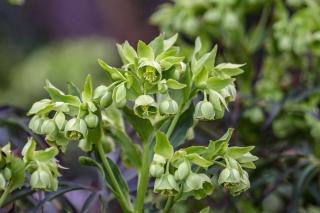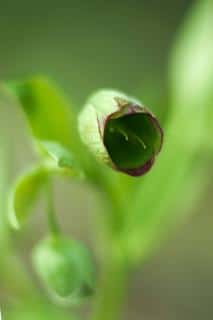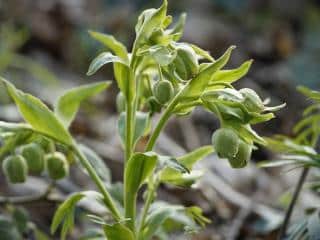

Stinking hellebore has other poetic names: bear’s foot, dungwort, snake rose, and even madman’s grass.
Stinking hellebore key facts
Botanical name – Helleborus foetidus
Common name – stinking hellebore
Family – Ranunculaceae
Type – perennial grassy flower
Exposure – sun to part shade
Soil – chalky, rocky, clayish, loamy, cool or dry
Foliage: evergreen
Blooming: mid-winter→mid-spring – Height: 1-3 ft (30-80 cm) – Toxicity: high
This plant is pretty common in Europe. Indeed, this herbaceous perennial grows in the wild along forest edges, in clearings and along roads, almost across the whole continent.
Stinking hellebore is a tall-stemmed hellebore that stands upright on thick, vertical stems 12 to 30 inches tall (30 to 80 cm). Large, 6 to 10 inch-long leaves are lance-shaped, clustered together to form larger fan-like structures. They have a deep green color. Flowers tend to rise far above this evergreen leafage.
When you crumple a leaf, it releases a foul, bad-smelling scent. When mature, Helleborus foetidus produces a tall, apical floral stem. The melliferous flowers are ½ to 1 inch across (1 to 3 cm). They’re shaped like slanted bells and never fully open. Their pale green color is rimmed with violet edges.
Dungwort loves growing in part sun and part shade, sheltered from wind, preferably on soil that is a bit chalky. The soil must stay cool, drain out well, and the pH range that’s best is lightly acidic to very alkaline. Very hardy (colder even than 5°F or -15 °C), stinking hellebore is an easy perennial to grow, but its growth is very slow. It needs 1 to 2 years just to settle in.


Be careful! Helleborus foetidus doesn’t like sitting water, it will make its roots rot away. However, you must also strike a balance: the soil should never dry out completely over the summer.

Stinking hellebore is vulnerable to black rot and its leaves occasionally show signs of black spot. As for pests, aphids and snails are its main enemies.
In olden days, the plant was considered medicinal and people tried using it to treat madness, but in reality, this is the most toxic garden plant of all. These compounds are the culprits: glucosides, helleborine, helleboreine, and saponin. All parts of the plant are toxic, and the roots are the most dangerous portion of the plant. Even simply touching the plant can lead to rashes and itchiness. Wear gloves to handle your stinking hellebore.
To learn more, read:
Can stinky hellibore be toxic for equines?
Hi Stella, yes. All the plants of the hellebore family are highly toxic to horses (to humans and other pets as well). For instance, just half a pound of fresh hellebore can kill a horse (250g). When it’s well dried and fermented, as is the case in hay fodder, the potency is reduced somewhat but there may still be mild effects of poisoning even when only a little bit is present. Large quantities, again, will kill animals of the equine family even if dried and fermented.